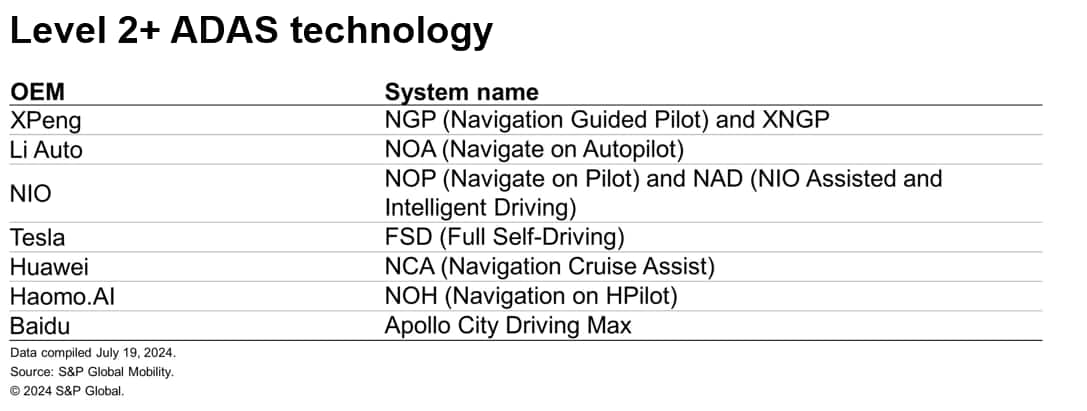Discover more about S&P Global's offerings
Customer Logins
Obtain the data you need to make the most informed decisions by accessing our extensive portfolio of information, analytics, and expertise. Sign in to the product or service center of your choice.
Customer Logins
BLOG
Jul 24, 2024
BriefCASE: Self-driven - Rising from the East
If you travel to mainland China 10 years from now, you will see more commercial autonomous vehicles operating on public roads than anywhere else in the world. That's an estimate based on the mainland Chinese government's focus to build a regulatory and economic environment for companies developing these cutting-edge technologies to survive and thrive.
The current enthusiasm for autonomous vehicles in mainland China is quite different from Europe and North America, where developers of such vehicles are contending with cost cuts, consumer apathy and calls for more regulation. For one, investment in smart infrastructure is a key focus area of the mainland Chinese government, both at the local and federal levels. From pilot projects to construct smart connected roads to issuing permits for the public testing autonomous driving technologies, mainland China is moving faster than many other countries on policy and investments.
What's the latest? Mainland China's capital city recently released the "Beijing Autonomous Driving Vehicle Regulations" aimed at establishing a comprehensive framework for the management, innovation and development of autonomous vehicles. The proposed regulation, the biggest initiative by the city since it first allowed road tests of autonomous vehicles in 2019, aspires to spark technological breakthroughs in core areas, including sensors, semiconductors, and software.
Mainland China's regulatory approach involves a combination of national standards and government directives designed to accelerate the development and deployment of autonomous vehicles. The Ministry of Industry and Information Technology (MIIT) and other agencies have issued several standards, such as "Guidelines on Establishing National Standards System of Telematics Industry" and "Administrative Provisions on Road Testing of Intelligent Connected Vehicles" to create a supportive environment for testing and commercializing autonomous vehicles across various cities, enabling rapid progress and extensive data collection.
Technology adoption trends
Mainland China is already a leader in the Level 2+ segment, which is projected to grow at a compound annual growth rate (CAGR) of 39% by 2030. This growth is fueled by the increasing adoption of advanced sensor hardware and application software in vehicles, as well as improvements in electric/electronic (E/E) architectures and over-the-air updates.
The mainland Chinese government's approval of Tesla's Full Self-Driving (FSD) feature highlights a strong willingness to elevate autonomous vehicle technology. Tesla's entry into the mainland Chinese market with its FSD feature, developed in collaboration with Baidu for mapping, will intensify competition among domestic and international players. This competitive pressure is likely to spur further innovation and expansion in the sector.
Several mainland Chinese companies have announced plans to roll out Navigation on Autopilot (NOA) systems across multiple cities. NOA systems are similar to Tesla's FSD, offering advanced driver-assistance capabilities such as autonomous stopping, steering, and lane-changing in urban environments. However, these systems still require human drivers to monitor and take control when necessary, classifying them as Level 2+ advanced driver assistance systems (ADAS).

By the end of this decade, Greater China is expected to emerge as the largest market for Level 3 and Level 4 vehicles as well. According to S&P Global Mobility, Greater China would likely account for more than 60% of global Level 3 vehicle output by 2030, followed by Europe (nearly 24%) and North America (nearly 13%). For global Level 4 vehicle output, Greater China's share could reach over 70% by 2030 followed by North America (16%) and Europe (11%).
Mainland China still faces challenges related to regulatory barriers such as clear guidelines and standards, data collection and privacy, and urban complexity and infrastructure development. However, its stronger push toward autonomous driving, supported by substantial government initiatives, investments, and regulatory frameworks, bode well for the future of autonomous vehicle industry in the country.
Authored by: Rohan Hazarika, Senior Research Analyst, Supply Chain & Technology, S&P Global Mobility
This article was published by S&P Global Mobility and not by S&P Global Ratings, which is a separately managed division of S&P Global.
{"items" : [
{"name":"share","enabled":true,"desc":"<strong>Share</strong>","mobdesc":"Share","options":[ {"name":"facebook","url":"https://www.facebook.com/sharer.php?u=http%3a%2f%2fstage.www.spglobal.com%2fmobility%2fen%2fresearch-analysis%2fbriefcase-self-driven-rising-from-the-east.html","enabled":true},{"name":"twitter","url":"https://twitter.com/intent/tweet?url=http%3a%2f%2fstage.www.spglobal.com%2fmobility%2fen%2fresearch-analysis%2fbriefcase-self-driven-rising-from-the-east.html&text=BriefCASE%3a+Self-driven+-+Rising+from+the+East++%7c+S%26P+Global+","enabled":true},{"name":"linkedin","url":"https://www.linkedin.com/sharing/share-offsite/?url=http%3a%2f%2fstage.www.spglobal.com%2fmobility%2fen%2fresearch-analysis%2fbriefcase-self-driven-rising-from-the-east.html","enabled":true},{"name":"email","url":"?subject=BriefCASE: Self-driven - Rising from the East | S&P Global &body=http%3a%2f%2fstage.www.spglobal.com%2fmobility%2fen%2fresearch-analysis%2fbriefcase-self-driven-rising-from-the-east.html","enabled":true},{"name":"whatsapp","url":"https://api.whatsapp.com/send?text=BriefCASE%3a+Self-driven+-+Rising+from+the+East++%7c+S%26P+Global+ http%3a%2f%2fstage.www.spglobal.com%2fmobility%2fen%2fresearch-analysis%2fbriefcase-self-driven-rising-from-the-east.html","enabled":true}]}, {"name":"rtt","enabled":true,"mobdesc":"Top"}
]}

